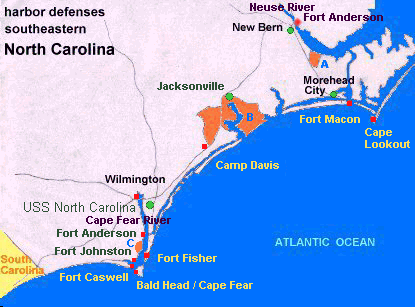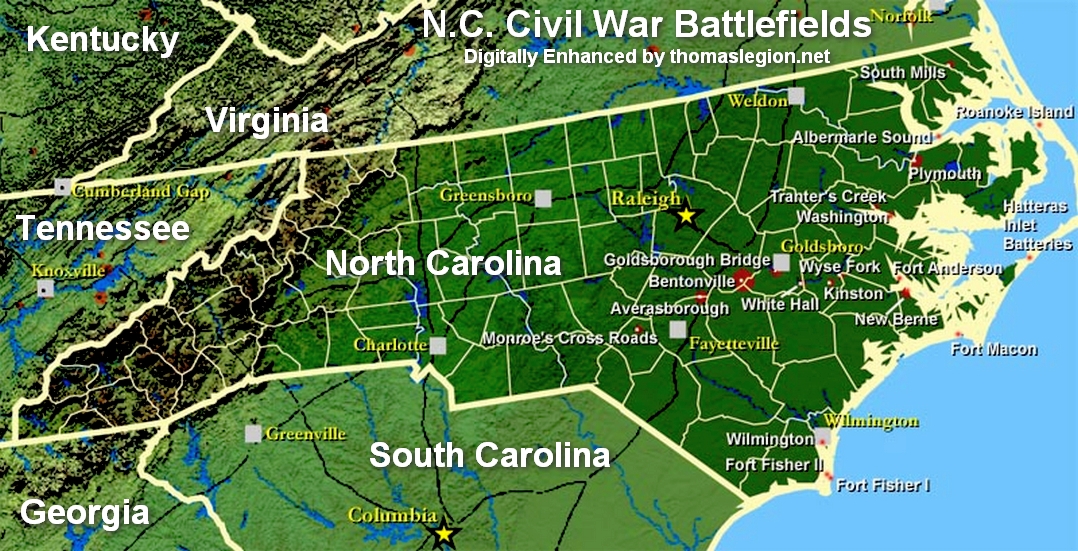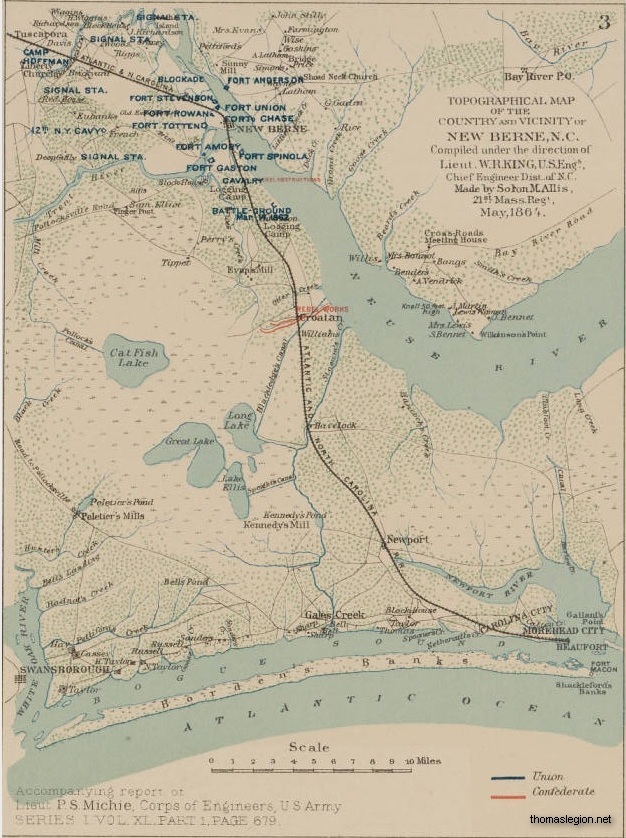|
Battle of Fort Anderson, North Carolina
North Carolina Coast and the American Civil War
Battle of Fort Anderson
Other Names: Deep Gully
Location: Craven County
Campaign: Longstreet's Tidewater Operations (February-May 1863)
Date(s): March 13-15, 1863
Principal Commanders: Lt. Col. Hiram Anderson [US]; Maj. Gen.
D. H. Hill [CS]
Forces Engaged: 1st Division, XVIII Corps [US]; Hill’s
Division [CS]
Estimated Casualties: 7 total
Introduction: Named in honor of Lt. Col. Hiram Anderson, Fort Anderson (aka Deep Gully) was
a Union constructed earthwork on the north bank of the Neuse River directly opposite New Bern. Fort Anderson, located
in Craven County, North Carolina, was a relatively small earthen fort that enjoyed strong natural defenses. It was flanked on both sides by swamps and was approachable only in front along a narrow causeway. Fort Anderson,
or Deep Gully, should not be confused with Confederate Fort Anderson, which protected Wilmington, located on the Cape Fear River to the south in New Hanover County. See also Fort Anderson on the Neuse, Potsdam [New York] Courier Freeman, March 9, 1864.
| North Carolina Civil War Coastal Forts Map |

|
| NC Coast and Outer Banks during the Civil War |
(Right) Map with location of forts on the North Carolina coast during the
Civil War as well as present-day military bases.
Map Key
(A) Cherry Point Marine Corps Air Station
(B) Camp Lejeune
Marine Corps Base &
New River Marine Corps Air Station
(C) US Army Sunny Point Ocean Terminals
Summary: Lt. Gen. James Longstreet assumed command of the Department of Virginia and North
Carolina on February 25 and initiated his Tidewater Operations. He directed D. H. Hill, commander of the North Carolina District,
to advance on the Union stronghold of New Bern (spelled New Berne at the time) with about 12,000 men. Maj. Gen. William H. T. Whiting, who commanded
the Wilmington garrison, refused to cooperate. After an initial success at Deep Gully on March 13, Hill marched against the
well-entrenched Federals at Fort Anderson on March 14-15. Hill was forced to retire upon the arrival of Union gunboats. The
city’s garrison was heavily reinforced, and Hill withdrew to threaten Washington,
North Carolina. Fort Anderson was a strategic objective in the Union Anaconda Plan.
| Battle of Fort Anderson History |

|
| Battle of Fort Anderson, North Carolina |
| Battle of Fort Anderson Map |

|
| Location of Battle of Fort Anderson |
History: After a Confederate victory at Fredericksburg,
Lt. Gen. James Longstreet was given the assignment to gather supplies and maintain supply lines for the North Carolina area. Longstreet
assumed control of the 45,000 men in the North Carolina and Virginia companies on February 25, 1863, and ordered Lt. Gen.
D.H. Hill, commander of the North Carolina district, and his 12,000 men from the North Carolina division, to regain control
of New Bern.
D.H. Hill devised a three-pronged plan to take control of New Bern. Marching from Kinston, Brig.
Gen. Junius Daniel would attack New Bern from lower Trent Road as Brig. Gen. Beverly H. Robertson led the cavalry to
New Bern by Upper Trent Road. Brig. Gen. James J. Pettigrew’s brigade and Major John C. Haskell’s artillery forces
were to attack the Federal Fort Anderson and gunboats from Barrington’s Ferry.
On March 13, 1863, Confederate
forces met the Federals eight miles outside of New Bern and pushed them back to Deep Gully. Fighting ensued at Deep Gully
and the Federals retreated to Fort Anderson. At daybreak the following day, Pettigrew unleashed steady and rapid fire
on the Federal earthworks. Pettigrew feared that an attempt to take the Fort would cost him between 50 to 100 men, so he planned
to bombard the Fort and then request U.S. Lieutenant Colonel Hiram Anderson’s surrender. After a fusillade lasting a
few minutes, Pettigrew sent his aide, Lieutenant Louis G. Young, to request the fort’s surrender, but Lt. Col. Anderson
refused.
Instead Anderson requested a ceasefire so that he could allegedly discuss the surrender with General Foster
in New Bern. Despite a warning from his lieutenant, Gen. Pettigrew accepted the ceasefire. Lt. Col. Anderson used the
ceasefire to allow Union gunboats time to assume a firing position. Once Anderson’s plan became apparent to Gen. Pettigrew,
Confederate forces were ordered to resume “rapid and terrific fire.” Pettigrew maintained his position attacking
the fort until Federal gunboats appeared and forced a retreat.
After Pettigrew’s withdraw, Hill was forced
to remove his troops from New Bern and head to Washington, NC. The mission was not a complete failure because D.H. Hill was
able to fill wagons with food supplies for the troops from areas that were not guarded by Union forces. It is estimated that
there were seven casualties at Deep Gully and Union Fort Anderson.
Sources: National Park Service; Official Records of the Union and Confederate
Armies; North Carolina History Project.
Recommended Reading: The
Civil War on the Outer Banks: A History of the Late Rebellion Along the Coast of North Carolina from Carteret to Currituck
With Comments on Prewar Conditions and an Account of (251 pages). Description: The ports at Beaufort, Wilmington, New Bern and Ocracoke, part of the Outer Banks (a chain
of barrier islands that sweeps down the North Carolina coast from the Virginia Capes to Oregon Inlet), were strategically
vital for the import of war materiel and the export of cash producing crops. From official records, contemporary newspaper
accounts, personal journals of the soldiers, and many unpublished manuscripts and memoirs, this
is a full accounting of the Civil War along the North Carolina
coast.
Recommended Reading: The
Civil War in Coastal North Carolina (175 pages) (North Carolina Division of Archives and History). Description: From the drama of blockade-running to graphic descriptions of battles
on the state's islands and sounds, this book portrays the explosive events that took place in North Carolina's
coastal region during the Civil War. Topics discussed include the strategic importance of coastal North Carolina, Federal occupation of coastal areas, blockade-running, and the impact of
war on civilians along the Tar Heel coast.
Recommended Reading: The Civil War in the Carolinas
(Hardcover). Description: Dan Morrill relates the experience
of two quite different states bound together in the defense of the Confederacy, using letters, diaries, memoirs, and reports.
He shows how the innovative operations of the Union army and navy along the coast and
in the bays and rivers of the Carolinas affected the general course of the war as well as
the daily lives of all Carolinians. He demonstrates the "total war" for North
Carolina's vital coastal railroads and ports. In the latter part of the war, he describes
how Sherman's operation cut out the heart of the last stronghold
of the South. Continued below...
The author
offers fascinating sketches of major and minor personalities, including the new president and state governors, Generals Lee,
Beauregard, Pickett, Sherman, D.H. Hill, and Joseph E. Johnston. Rebels and abolitionists, pacifists and unionists, slaves
and freed men and women, all influential, all placed in their context with clear-eyed precision. If he were wielding a needle
instead of a pen, his tapestry would offer us a complete picture of a people at war. Midwest Book Review: The Civil War in the Carolinas by civil war expert and historian
Dan Morrill (History Department, University of North Carolina at Charlotte, and Director of the Charlotte-Mecklenburg Historical
Society) is a dramatically presented and extensively researched survey and analysis of the impact the American Civil War had
upon the states of North Carolina and South Carolina, and the people who called these states their home. A meticulous, scholarly,
and thoroughly engaging examination of the details of history and the sweeping change that the war wrought for everyone, The
Civil War In The Carolinas is a welcome and informative addition to American Civil War Studies reference collections.
Recommended
Reading: American Civil War Fortifications (1): Coastal brick and stone forts (Fortress). Description: The 50 years before the American Civil War saw a boom in the construction
of coastal forts in the United States of America.
These stone and brick forts stretched from New England to the Florida Keys, and as far as the Mississippi
River. At the start of the war some were located in the secessionist states, and many fell into Confederate hands.
Although a handful of key sites remained in Union hands throughout the war, the remainder had to be won back through bombardment
or assault. This book examines the design, construction and operational history of those fortifications, such as Fort Sumter, Fort
Morgan and Fort Pulaski, which played a crucial part in the course of the Civil War.
Recommended Reading: Ironclads and Columbiads: The Coast
(The Civil War in North Carolina) (456 pages). Description: Ironclads and Columbiads covers some of the most
important battles and campaigns in the state. In January 1862, Union forces began in earnest to occupy crucial points on the
North Carolina coast. Within six months, Union army and
naval forces effectively controlled coastal North Carolina from the Virginia
line south to present-day Morehead City.
Union setbacks in Virginia, however, led to the withdrawal of many federal soldiers from North Carolina, leaving only enough
Union troops to hold a few coastal strongholds—the vital ports and railroad junctions. The South during the Civil War,
moreover, hotly contested the North’s ability to maintain its grip on these key coastal strongholds.
Recommended
Reading: Seacoast Fortifications of the United States:
An Introductory History. Reader’s
Review: In the thirty years since this book was published, one always hoped another would equal or surpass it. None has, or
perhaps ever will. It is a marvelous history of the Forts along the American Seacoast, both Atlantic and Pacific, and even
the Philippines. …Any Fort enthusiast
must read this book. The author captures so much information, so many views, so much perspective in so few pages, the book
is breathtaking. It is easily the finest book on its chosen subject, which is why it never goes out of print. “If forts
interest you, read it, period.” The photographs from the author's collection, the army's files, the National Archives,
etc., make it an invaluable edition. Continued below…
But the text, the clear delineation of the periods of
fort building since 1794 in the US, and the differentiation of the periods, are so
worth while. Ray manages to be both terse, and pithy. It is a great tribute to any author to say that. “This is a MUST
read for anyone interested in the subject, even one only interested in their own local Fort, and how it relates to the defense
plans of the United States when it was built.” “[T]here is NO better book to read on the subject.”
|

